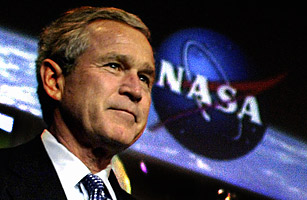
On the 20th anniversary of the Apollo 11 moon landing, President George H.W. Bush capitalized on the excitement surrounding the commemoration of the landmark spacewalk by announcing big goals for the U.S. space program. In remarks delivered at the Smithsonian National Air and Space Museum on July 20, 1989, he said the U.S. would go, "Back to the moon: back to the future. And this time, back to stay," hinting at the much promised manned moon base that was supposed to have gotten under way in the 1970s. He also said the U.S. would launch a manned mission to Mars. Though Bush's announcement served to excite NASA and the public, the numbers weren't pretty. A NASA study estimated the long-term cost of Bush's plan would be approximately $500 billion — a staggering figure, even when spread across 20 to 30 years. As a result, NASA transitioned away from human exploration and focused on earth and space science.
Following in his father's footsteps, President George W. Bush announced on Jan. 14, 2004, that the U.S. would return to the moon by 2020. "We do not know where this journey will end, yet we know this: human beings are headed into the cosmos." Bush announced an ambitious plan to send robotic probes to the lunar surface by 2008, followed by a manned mission by 2015. While Bush's charge prompted NASA to start Constellation, a project aimed at sending humans to the moon, the plan was scrapped by President Barack Obama as part of his 2011 budget proposal. Instead of funding moon walks, Obama plans to invest in space-technology research.